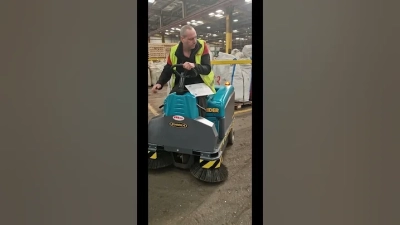Leave Your Message
More than ever before, it has become quite essential to procure quality cleaning equipment for sweeping in today's dynamic and competitive market, especially when it comes to Ride On Sweepers. These highly powerful machines increase efficiency and enhance the productivity of businesses, thus enabling them to have and maintain the necessary standards of cleanliness in their operational environments. Yet, with the increasing emphasis on sustainability and operational excellence in business, the factors in choosing the right Ride On Sweeper become vitally important for those in the cleaning business.
Here is Anhui Shuojie Environmental Equipment Co., Ltd, lying in this new situation, contributing to the making of high-quality cleaning solutions. Our specialty lies in commercial Floor scrubbers, sweepers, vacuum cleaners, and various other cleaning equipment, so we innovate and incorporate so that what we create can best serve the different needs of our clients. Sourcing Ride On Sweepers within acceptable standards will bring not only improvements for organizations concerning operational efficiency but also contribute toward a cleaner, more sustainable environment.

When choosing the right kind of ride-on sweeper from the assorted types, it is important to get familiar with the different kinds before making that crucial decision. Industrial sweepers are built mainly for heavy duty applications in warehouses and manufacturing, and most common among the types of sweeper available. They are robust with powerful suction and large debris collection bins. This makes them ideal for sweeping over large areas with large amounts of dirt and debris. The other popular type is the commercial ride-on sweeper for use within public areas like parks, parking lots, and shopping centers. These types of sweepers generally strike a balance between efficiency and having some comfort features like ergonomic controls and maneuverability for the operator to easily maneuver around tight areas. They are usually quiet in their operations, suitable for use within noise-sensitive areas. This really is a great method for small area or lesser intensity cleaning. These machines are lightweight and more maneuverable than larger models. Such units are ideally suited for urban situations or facilities where space is limited and offer a cleaning capability without sacrificing performance, addressing a very wide range of commercial cleaning applications. With knowledge of these different types, it will be easy for any business to choose a ride-on sweeper that fits its configuration and operations.
A few key features play a fundamental role in determining a ride-on sweeper's quality performance and reliability in today's market. One such feature is the efficiency of the sweeping system. A reliable ride-on sweeper must have a very strong brush system that will pick up all debris and dust even in extreme conditions: everything from brush types to rotational brush speed and adjusting brushes for different types of surfaces.
Another factor to consider is the power source and battery life. As the cleaning sector increasingly becomes dedicated to sustainability, a ride-on sweeper with good battery performance would fit the bill. Good battery life allows the machinery to run for long hours without pausing, which is desirable for large spaces. For easy maintenance, a good machine should be designed for easy-wash and quick service: easy-wash systems will cut down simple maintenance, allowing for minimal downtime which increases the machine's longevity.
User-friendly features will also be crucial for the ride-on sweepers' operational effectiveness. Look for models with intuitive controls, ergonomic seating, and good visibility. While enhancing the operator's experience, these qualities also enhance the safety of the process. Keeping up with current innovations and standards will help you make an informed choice on the best ride-on sweepers out there.
In the current market scenario, it becomes imperative for every entity intending to keep standards of cleanliness high and cut costs to assess the performance and efficiency of ride-on sweepers. As revealed in a recent report published by ResearchAndMarkets, the global market for ride-on sweepers is projected to reach US$ 4.92 billion by 2025, thus growing at a compound annual growth rate (CAGR) of 5.3%. The increasing demand for efficient cleaning of streets within urban municipalities serves as an excellent impetus for assessing various models together with their operational capabilities.
While discussing some performance metrics, one may think of sweeping width, debris capacity, and fuel consumption. According to a study by the Cleaning Equipment Trade Association (CETA), these savings run from 30% in operating costs of a ride-on sweeper operated perfectly on fuel as opposed to older models. Moreover, advance batteries have paved the way for electric ride-on sweepers that serve mainly in aiding efficiency and contribute to the global campaign for sustainability and lesser emissions.
So, also, the simple maintenance and availability of spare parts have a major say in the effective overall operation of ride-on sweepers. It can prolong the life of equipment, with some models boasting an operational life of over 10 years before maintenance. As companies have started investing in new machines, it would also be meaningful to choose machinery with a combination of strong performance metrics and sustainable practices for operational as well as environmental efficiency.
In the competitive market today, reliability and longevity are very important factors to be considered while procuring quality ride-on sweepers. All the reports in the industry state that the lifecycle cost of sweepers impacts operational budgets to a very large extent, and according to the Global Market Insights report, more than 30% of a sweeper's total cost of ownership is incurred in maintenance costs. Thus, investing in models that are reliable will enhance performance while at the same time, minimize these hidden expenses.
Material evaluation and construction of a sweeper play a key role in judging the other aspects of durability. Such reports prove that units made using high-grade component are capable of extending the functional life of the device by as much as 25%. For instance, stainless-steel bodies are more resistant to corrosion as well as wearing down rather than normal steel, which is the reason why they are recommended for appalling environments. In addition, knowing the manufacturer's warranty and what type of service support is available might give hints about their own confidence in the robustness of the product.
Performance parameters, such as efficiency in debris collection and battery life, are part of reliability assessment measures. According to the research by the Cleaning Equipment Trade Association (CETA), an efficient sweeper picks more than 99% of debris in a single pass, which is proof of effectiveness. Additionally, with the recent advancement in battery technology, many ride-on sweepers can now run for longer than 10 hours without recharging, making them highly efficient for continuous operations without interruptions from frequent recharging breaks.
While sourcing options for good-quality ride-on sweepers in today's competitive market, the after-sales support and maintenance services will play a very important part in after-satisfaction and operational efficiency. The competition demands fair performance of the machine and a commitment to its upkeep. Buyers should look for a supplier that has proper after-sales services, which include prompt repairs and easily available spare parts. Such support goes a long way in minimizing downtime and maximizing the productivity of the sweepers.
On the other hand, maintenance services are another consideration altogether. Scheduled and unscheduled maintenance increases the equipment's productive life and ensures that it works efficiently at optimal capacity. This is especially critical when a high level of cleanliness is mandatory for the particular industry. Companies should, therefore, partner with those who provide full maintenance plans, including routine service checks, preventive care, and emergency repairs. Such partnerships increase the reliability of the equipment and grow a forever trusted business relationship based on service excellence.
In an age where operational efficiency relies even more on machine availability, investment in quality after-sales support and maintenance services stands first among worth-considering priorities for surviving businesses. Partners can successfully ensure that investments in ride-on sweepers realize operational success for the long haul.
One important when investing in a ride-on sweeper is the cost in balance to value. Competitive market conditions invariably put pressure on businesses to contain expenditures. However, going straight for the cheapest option price may leave some regrettable choices later on regarding quality and efficiency. Budgeting for a ride-on sweeper must rank in a very high position when considering both upfront costs and the long-term value that the machine brings to your operations.
Total cost of ownership must be analyzed here. This does not just apply to the purchase price, but maintenance, fuel usage, and any downtime factors. More expensive, high-quality sweepers might cause you a few pretty pennies at first, yet after due consideration, you'll discover that their longer-lasting durability and efficiency allow you considerable savings. Also consider special features that target the particular cleaning needs that arise in your organization-whether that is extra-efficient filtration systems or operator comfort. If these extra features lead to higher productivity and satisfaction, they might warrant the increased expense.
The ROI from minimized labor costs and enhanced cleanliness can also shed light on the true value of a ride-on sweeper. Purchasing good machines means less repair frequency and more uptime, so clean work environments can be maintained. Once again, through this approach, a sensible budgeting decision will not only ensure the right purchase is made but will also lay down a future for your business in this rapidly competitive environment.
In the present competitive market scenario, it is essential to look out for good manufacturers and suppliers of quality ride-on sweepers. According to a recent report published by IBISWorld, it was noted that the global market for street cleaning equipment will increase by an average of 4.5% every year over the next five years, showing an increase in demand upon effective cleaning solutions across various sectors. The increasing trend underlines how important it is to choose a manufacturer who can not only fulfill the present quality requirement but also has what it takes to innovate with the market changes in future needs.
Researching a supplier entails looking at its reputation in the industry as well as its accreditation. For instance, suppliers who have ISO 9001 are believed to have quality management system practices. In the same line, sourcing from manufacturers who exercise strong sustainable practices has become very plausible for consumers. EcoVadis report shows that nearly 70% of consumers are likely going to purchase from environmentally responsible companies. Those kinds of suppliers tend to strengthen their positions and reliability before possible clients by using ecological technology.
They can attend trade and industry exhibitions, which may give room for ideas concerning advancements in ride-on sweepers. Such a process involves interaction among industry players and gets a hands-on view of different models to provide all needed information for better informed judgments. This is highly important in the market, where, in some cases, the performance of the cleaning equipment is very important for the efficiency and productivity of operations. A well-understood market and supplier vetting will benefit a business in terms of cleaning solutions.
The ride-on sweeper evaluation is not just about specs and pricing; it is equally important to get behind the wheel and test the machine for yourself in order to assess how it performs in real-life situations. Start with the controls and features: the steering system, sweeping action, and overall handling. A hands-on evaluation will determine whether this sweeper suits your own operational expectations and requirements.
At the same time, take note of how efficiently the machine picks up different material types. See how well the sweeper moves around obstacles and can sense and gather debris. It would also be wise to explore how the machine may integrate smart functions to leverage the productivity of recent developments in autonomous cleaning technologies, like fully automated sweeping machines displayed at the upcoming Expo, thus relieving operator fatigue significantly. Be sure to also inquire about the software and support for any advanced technologies you may be looking at, as this could considerably affect your decision.
Evaluating performance is crucial for businesses to maintain high cleanliness standards while optimizing costs. It helps in assessing different models and their operational capabilities.
Key factors include sweeping width, debris capacity, fuel efficiency, and the overall operational capabilities of the machines.
Ride-on sweepers with optimal fuel consumption can reduce operational costs by up to 30% compared to older models.
After-sales support is essential for ensuring long-term satisfaction and operational efficiency, minimizing downtime, and maximizing productivity.
Regular maintenance, including routine inspections, preventative care, and emergency repairs, is critical for extending equipment lifespan and ensuring optimal efficiency.
Businesses should evaluate suppliers based on their industry reputation, adherence to quality standards like ISO 9001, and their commitment to sustainability practices.
With nearly 70% of consumers preferring environmentally responsible companies, manufacturers that prioritize eco-friendly technologies are more appealing and reliable.
Trade shows provide opportunities to gain insights into the latest advancements, network with industry professionals, and explore various models, aiding informed purchasing decisions.
The global market for ride-on sweepers is expected to reach $4.92 billion by 2025, growing at a CAGR of 5.3%, driven by the demand for efficient cleaning solutions.
By selecting reputable suppliers and ensuring robust after-sales support and maintenance services, companies can maximize the operational efficiency and longevity of their equipment.





